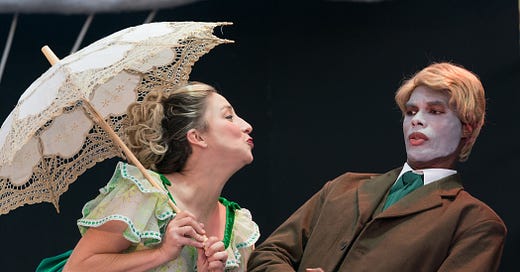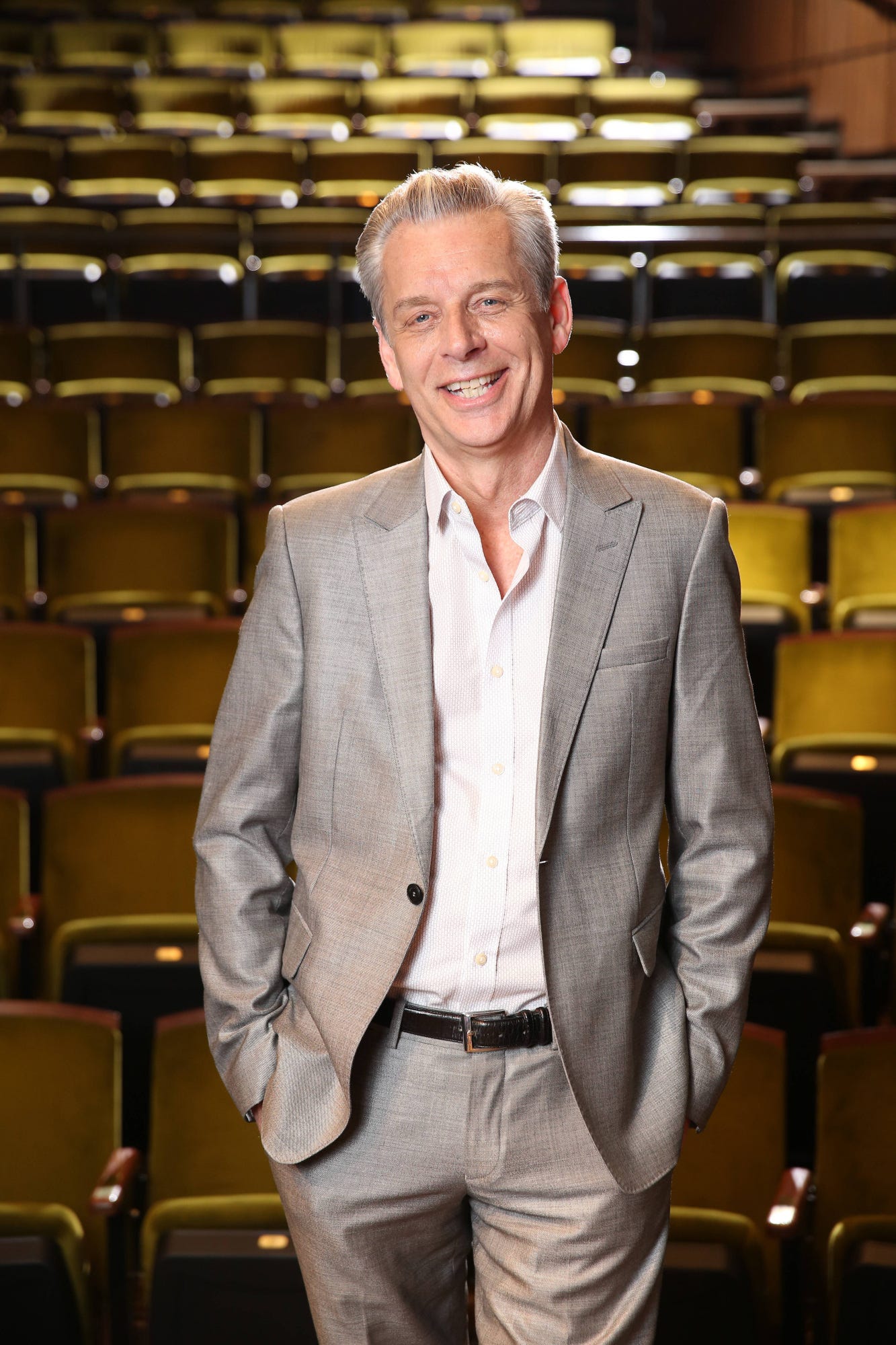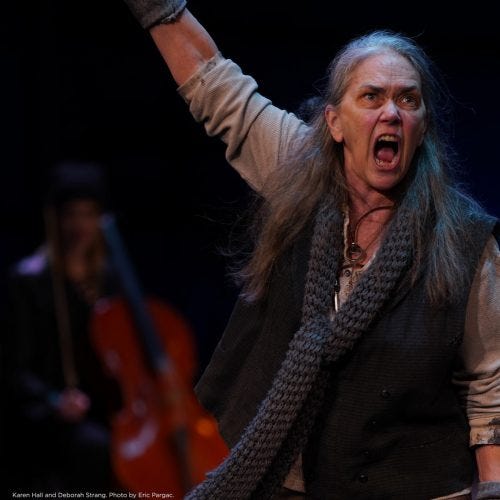Rise and shine, LA theater
In-person theater is back, following COVID plus two momentous offstage changes
Theater in Los Angeles hasn’t been completely asleep during the pandemic. Behind the scenes, theater makers are contemplating who might replace the city’s most prominent artistic director — and what might replace the area’s largest intra-theater organization.
During the COVID months, many theaters tried to remind us of their existence — and stanch the loss of box-office revenue — by luring us to online activity. But this virtual activity is not “theater,” with its definitional promise of a live in-person experience. Much of it is closer to being low-budget television or online games. So, while the LA theater scene hasn’t disappeared into complete slumber, it certainly felt drowsy lately.
For many people, this merely magnifies the image of LA theater that usually exists. Sure, if asked, most Americans would know that LA has plenty of professional actors, directors, writers, designers and other theatrical practitioners. But the general perception — not only in the rest of America but even in LA — is that that these people are interested primarily in making big bucks in the screen industries. And for some of them, that’s certainly true.
Yet after years of observing LA theater, I know that many of its participants are excited more by their in-person theatrical adventures than they are by the work they occasionally or even frequently do in film or television or video. Even if some of the older artists, feeling the necessity of making more money, retire from the theatrical fields, they’re constantly replaced by new generations of theater devotees.
Until 15 months ago, Angelenos who were excited by being part of live audiences for theater normally had plenty of options — even if most of these productions had a low profile in comparison to just about any movie or TV or streaming series. But then COVID arrived, and most of us retreated from theaters to our home screens.
Now, however, theater companies are announcing their plans for the return of in-person productions. More such announcements are likely since California eliminated many COVID restrictions on Tuesday. This weekend the Fountain Theatre opened its new outdoor space with “An Octoroon”. I’ll write more about it in my next post.
It’s an ideal moment to resume the LA-based LA-theater-centric column that I’ve written for years on various platforms. But now it’s on Substack, currently the pacesetter of the newsletter sites that are emerging as a new forum for independent journalism. I hope that Angeles Stage can help spread the word about the Los Angeles stage.
Of course this shouldn’t be primarily a task for journalists — independent or otherwise. Theater artists in far-flung greater LA need their own non-profit organization that will unite them in self-promotional efforts.
Unfortunately, the organization that already existed for this purpose, LA Stage Alliance (LASA), collapsed in early April.
Farewell, LASA. Hello…?
LA theatrical irony of the year so far: The death of LA Stage Alliance attracted more national media coverage — the New York Times, even — than anything that LASA accomplished during its life. The obituaries initially suggested that the death was due almost entirely to insensitive missteps at the last ceremony that LASA produced (virtually) for its annual Ovation Awards. However, subsequent articles on Medium and in posts on social media contended that LASA’s problems existed long before April.
I’m not going to wade into those details here. I want to make only two points about LASA:
First, a replacement for LASA could and should help restore the public image of LA theater to at least the tenuous level that existed before COVID. One question to consider — did the Ovation Awards actually attract attention to LA theater beyond those people who were up for the awards? The LA Times barely mentioned them in most recent years; how many potential newbie theater visitors were even aware of them? In other words, do they serve a purpose beyond their use on the winners’ resumes?
Second, LASA’s publications — including LA Stage Times, where an earlier version of this column appeared under the title LA Stage Watch from late 2009 to early 2014— should be digitally preserved, for the sake of LA theater history. A library, a university, or some other non-profit repository of LA’s cultural heritage, might need to volunteer its services.
Farewell, Michael Ritchie. Hello…?
Probably an even more consequential announcement for LA theater during the past few months was the June 10 news that Michael Ritchie, artistic director of Center Theatre Group — LA’s flagship non-profit theater company — plans to retire at the end of 2021.
Ritchie is only CTG’s second artistic director. He was chosen in 2003 to replace the group’s founding leader, Gordon Davidson, as 2005 began. When Ritchie landed the job, it was no surprise that the other final contenders were also white men — Gregory Boyd and Oskar Eustis. Yet in 2022, the chance of a third white-male artistic director is probably slim. Ritchie acknowledged as much in his comments about “the need for new and diverse voices.”
In the Los Angeles Times, critic Charles McNulty immediately floated (without necessarily endorsing) a couple of intriguing ideas. CTG could appoint different leaders for each of its three venues: the Mark Taper Forum, Ahmanson Theatre and Kirk Douglas Theatre. And apparently McNulty took rather seriously an expressed wish by playwright Jeremy O. Harris, now 32, that he would like to run CTG some day.
The idea of splitting the leadership into separate domains for each of the three venues might work, or might not, depending to a large degree on how well the particular leaders get along with each other — as well as with whomever would be the arbiter if the three of them end up in competitive turf battles. It also could allow CTG to name leaders from three different ethnicity/gender combinations, although there might be some ethnic/gender-influenced infighting as to who controls which theaters. It sounds complicated.
Regarding the idea of Harris, he lived briefly in LA, but is he really more familiar with LA theater than Ritchie was in 2003? Like Ritchie, Harris might easily draw criticism that he’s too New York-oriented. At least Davidson, who was about the same age when he took on the Taper as Harris is now, had already run another LA theater company.
More than five decades later, it’s finally time for the CTG artistic director to again be someone who knows the theater ecology here firsthand, who has intensive experience in the local trenches, thinking about LA’s remarkably diverse audiences and its enormous reserves of talent.
And consequently it should be no surprise that the new leader should be well aware that about half of the population of Los Angeles is Latinx.
Since the late Diane Rodriguez left CTG in 2019, no Latina or Latino has been a part of CTG’s “artistic team” as listed on the CTG website. Even if the next artistic director isn’t Latinx, whoever gets the job should prepare to be reminded, repeatedly, of the size of the Latinx proportion of the LA population — and to figure out how to incorporate that fact into programming choices.
The next artistic director of CTG also should have a few ideas about potential productions that are set in contemporary as well as in historical Los Angeles — and be able to make these ideas come to life on CTG stages.
During the last few weeks, I’ve been avidly watching Netflix’s “Gentefied,” which is set in contemporary Boyle Heights, less than three miles from the Music Center, where CTG is based. I’m not saying that CTG should try to turn “Gentefied” (or the Cuban-American version of the series “One Day at a Time,” which was set in Echo Park, also close to the Music Center) into plays, but the company’s next leader should be able to draw similar narrative inspiration from our own area.
The Music Center itself is owned and maintained by Los Angeles County — in other words, by all of us who live in this county. The Music Center’s resident theater company should be run by someone who thoroughly understands what that means.
Farewell, pandemic-era not-quite theater. Hello…?
I won’t spend a lot of space discussing the various virtual offerings of LA theater companies during the past 15 months. Many of them are no longer available. But I will single out a couple of them that didn’t get quite as much attention as those from larger theaters but which seemed to be more successful than most — perhaps even successful enough to warrant in-the-flesh stagings.
Just when voters were seeing attack ads on TV last fall, before the election, they also could see Sean Devine’s “Daisy,” in International City Theatre’s virtual version. The play is about the creation of a famous TV ad for Lyndon Johnson’s 1964 campaign that is often cited as the inspiration for the hundreds of attack ads that we’ve seen since then. Because the play focuses on the creation of a small-screen product, it might have been particularly well-suited to watching on a small screen. Still, I’d also like to see how well it would work in a theater.
The Troubadour Theater rowdies produced a six-short-episode online series, along with the Getty Villa, called “The ODDyssey”. It was funny enough, but my own solitary chuckles lacked the contagious quality that’s usually generated when the Troubies perform live. When I heard that they would be at the Getty Villa in September with a new production, I guessed that they had adapted “The ODDyssey” into a full-length stage version. But the leader of the Troubie pack, Matt Walker, tells me that instead they’ll be adapting “Lysistrata” into “Lizastrata,” incorporating some of Liza Minnelli’s greatest hits.
OK, that sounds promising too, but I’m not giving up on a staged “ODDyssey.” Maybe give it another year, after which those who saw the Troubies’ online version will have forgotten most of its jokes, and new punchlines will be waiting in the wings.
Speaking of Homeric adaptations: A Noise Within introduced its production of Lisa Peterson’s and Denis O’Hare’s “An Iliad” online during the pandemic but has now announced that a live stage version — actually, two versions — will open in Pasadena in September. I wasn’t particularly impressed when O’Hare himself performed this at Broad Stage in 2014. But I liked Deborah Strang’s online performance as the online storyteller for A Noise Within. I didn’t see the company’s second version with Geoff Elliott.
I’m currently undecided about whether to see Strang live, or see Elliott instead, or both, or neither — because there might be so many other shows competing for attention in September.
Is it conceivable that LA theater could return to its previous state of abundance by then, or will companies and audiences hesitate for at least few more months? I don’t know, but I hope you’re as eager to find out as I am.






